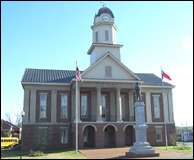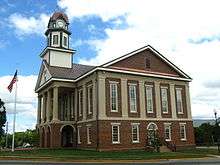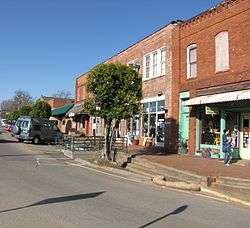Pittsboro, North Carolina
| Pittsboro, North Carolina | |
|---|---|
| Town | |
|
Hillsboro Street in downtown Pittsboro | |
| Nickname(s): Circle City | |
|
Location of Pittsboro, North Carolina | |
| Coordinates: 35°43′13″N 79°10′35″W / 35.72028°N 79.17639°WCoordinates: 35°43′13″N 79°10′35″W / 35.72028°N 79.17639°W | |
| Country | United States |
| State | North Carolina |
| County | Chatham |
| Area | |
| • Total | 4.2 sq mi (10.8 km2) |
| • Land | 4.1 sq mi (10.7 km2) |
| • Water | 0.04 sq mi (0.1 km2) |
| Elevation | 394 ft (120 m) |
| Population (2010) | |
| • Total | 3,743 |
| • Density | 905/sq mi (349.3/km2) |
| Time zone | Eastern (EST) (UTC-5) |
| • Summer (DST) | EDT (UTC-4) |
| ZIP codes | 27228, 27312 |
| Area code(s) | 919 |
| FIPS code | 37-52660[1] |
| GNIS feature ID | 1021992[2] |
| Website |
pittsboronc |
Pittsboro is a town in Chatham County, North Carolina, United States. The population was 3,743 at the 2010 census.[3] It is the county seat of Chatham County.[4]
History
Pittsboro was established as a town in 1785. The Chatham County Court House stood on land belonging to Mial Scurlock; however, in 1787, the legislature declared that a town could not be established on Scurlock's land. The town's trustees instead purchased adjacent land belonging to William Petty and laid out the town. That same year, Pittsboro was officially named the county seat. Although Chatham County is named for William Pitt, 1st Earl of Chatham, Pittsboro is named for his son, William Pitt the Younger.
Pittsboro was once considered as a potential site for both the University of North Carolina and the state capitol. The university was eventually sited in Chapel Hill, while the state capitol was located 34 miles (55 km) to the east of Pittsboro, in Raleigh.
Charles M. Stedman, the last Civil War veteran to serve in Congress, was born in Pittsboro on January 29, 1841.
The Alston-DeGraffenried House, Aspen Hall, Baldwin's Mill Sheriff Stephen Wiley Brewer Farmstead, Chatham County Courthouse, Luther Clegg House, Lewis Freeman House, Hadley House and Grist Mill, Hall-London House, Kelvin, London Cottage, Henry Adolphus London House, McClenahan House, Moore-Manning House, Pittsboro Historic District, Pittsboro Masonic Lodge, Pittsboro Presbyterian Church, Reid House, Patrick St. Lawrence House, A. P. Terry House, and James A. Thomas Farm are listed on the National Register of Historic Places.[5]
National Football League wide receiver Tobais Palmer is from Pittsboro.
City government
The mayor of Pittsboro is Bill Terry. The town's Board of Commissioners consists of Pamela Baldwin, Jay Farrell, Bett Wilson Foley, Beth Turner, and Michael A. Fiocco. The town manager is Bryan Gruesbeck.
Educational facilities
The town is served by four local schools:
- Pittsboro Elementary School
- Horton Middle School
- Margaret B. Pollard Middle School
- Northwood High School.
One of Central Carolina Community College's many campuses is located in Pittsboro.
- Central Carolina Community College (CCCC), Chatham County Campus, is located on the western edge of town.
The Pittsboro Campus of Central Carolina Community College is known for its cutting edge programs like
- Green Technologies
- Brochure
- Sustainable Agriculture
- Sustainable Technologies
- Green Building / Renewable Energy
- Ecotourism
- The Confucius Classroom Chinese Studies. CCCC is the first community college in the United States to have such a program.
- Creative Writing
- Culinary & Hospitality Arts
Media outlets
- Newspapers
- Chatham Journal (weekly, based in Pittsboro) [6]
- The Chatham News (daily, based in Siler City)[7]
- The Chatham Record (daily, based in Pittsboro)[8]
- Network television
- Digital News Channels
- Chatham Chatlist (daily, based in Pittsboro, founded and managed by Gene Galin) [9]
- Chatham Post (daily, based in Pittsboro) [10]
- Magazines
- Chatham Magazine (several times a year, based in Pittsboro, founded and managed by Heather Johnson) [11]
Geography
Pittsboro is located east of the center of Chatham County at 35°43′13″N 79°10′35″W / 35.72028°N 79.17639°W (35.720332, -79.176393).[12]
According to the United States Census Bureau, the town has a total area of 4.2 square miles (10.8 km2), of which 4.1 square miles (10.7 km2) is land and 0.04 square miles (0.1 km2), or 0.86%, is water.[3]
U.S. Highways 15 and 501 run concurrently through the center of the town as Hillsboro Street and Sanford Road, leading north 17 miles (27 km) to the center of Chapel Hill and the University of North Carolina, and south 17 miles (27 km) to Sanford. U.S. Route 64 bypasses Pittsboro to the north and leads east 34 miles (55 km) to Raleigh and west 16 miles (26 km) to Siler City. U.S. Route 64 Business passes through the town as West Street and East Street, crossing US 15/501 at the traffic circle that surrounds the historic Chatham County Courthouse in the center of town. North Carolina Highway 87 leads northwest from Pittsboro 32 miles (51 km) to Burlington.
Near the geographic center of the state, Pittsboro is 150 miles (240 km) from Wilmington at the coast and the same from Boone in the Blue Ridge Mountains.
Jordan Lake is 8 miles (13 km) east, providing recreation, fishing, boating and scenic panoramas. The lake is 14,000 acres (5,700 ha) of surface and provides water for Raleigh and the town of Cary.
Demographics
| Historical population | |||
|---|---|---|---|
| Census | Pop. | %± | |
| 1900 | 424 | — | |
| 1910 | 502 | 18.4% | |
| 1920 | 584 | 16.3% | |
| 1930 | 675 | 15.6% | |
| 1940 | 826 | 22.4% | |
| 1950 | 1,094 | 32.4% | |
| 1960 | 1,215 | 11.1% | |
| 1970 | 1,447 | 19.1% | |
| 1980 | 1,332 | −7.9% | |
| 1990 | 1,436 | 7.8% | |
| 2000 | 2,226 | 55.0% | |
| 2010 | 3,743 | 68.1% | |
| Est. 2014 | 4,063 | [13] | 8.5% |
2010 Census The Census of 2010 shows a population of 3,743, 68% growth since 2000. The racial makeup of the town was: 72% White, 19% African American, 4% some other race alone, 2% two or more races. Almost 9% of the population was Hispanic or Latino. 54% of the population is female and 46% male.
2000 Census As of the census[1] of 2000, there were 2,226 people, 855 households, and 535 families residing in the town. The population density was 663.1 people per square mile (255.8/km²). There were 939 housing units at an average density of 279.7 per square mile (107.9/km²). The racial makeup of the town was 64.38 percent White, 27.54 percent African American, 0.49 percent Native American, 0.67 percent Asian, 0.04 percent Pacific Islander, 4.99 percent from other races, and 1.89 percent from two or more races. Hispanic or Latino of any race were 8.81 percent of the population.
There were 855 households out of which 29.0 percent had children under the age of 18 living with them, 40.9 percent were married couples living together, 18.7 percent had a female householder with no husband present, and 37.4 percent were non-families. 32.3 percent of all households were made up of individuals and 12.7 percent had someone living alone who was 65 years of age or older. The average household size was 2.34 and the average family size was 2.97.
In the town the population was spread out with 22.9% under the age of 18, 7.3 percent from 18 to 24, 28.7 percent from 25 to 44, 19.6 percent from 45 to 64, and 21.5 percent who were 65 years of age or older. The median age was 39 years. For every 100 females there were 80.7 males. For every 100 females age 18 and over, there were 75.0 males.
The median income for a household in the town was $35,800, and the median income for a family was $42,391. Males had a median income of $29,500 versus $26,719 for females. The per capita income for the town was $16,863. About 19.2 percent of families and 18.3 percent of the population were below the poverty line, including 24.3 percent of those under age 18 and 13.7 percent of those age 65 or over.
Economy
Once home to textiles, the largest clothing label mill in the world, and poultry, the town now depends on commuter income, retail stores and a developing business in genetics. Housing developments provide relief from loss of industry as the town adjusts to a new economy.
The water supply is abundant, derived from the Haw River and, in the future, Jordan Lake. In 2010, the wastewater allotment was expanded. The town is 15 miles (24 km) and 25 miles (40 km) from major power plants. Major corridor highways, US 15-501 and US 64, a four-lane divided highway, intersect there.
Pittsboro is home to the Chatham County Government, the Chatham County Justice Center, and many non-profit agencies and other social service organizations. Pittsboro is also a Certified Retirement Community.
Government
For Businesses & Non Profits
For Visitors
- The Pittsboro-Siler City Convention & Visitors Bureau
- The Chatham Historical Museum
- Chatham County Historical Association, Inc.
For Retirement
For the Arts
For Agriculture and Nature
- Carolina Farm Stewardship Association
- Rural Advancement Fund
- Haw River Assembly
- Pittsboro Matters
- The Abundance Foundation
For People
- Chatham Habitat for Humanity
- CORA Food Pantry
- Family Violence and Rape Crisis Services
- Chatham Council on Aging
For Animals
- The Livestock Conservancy
- Chatham Animal Rescue and Education Inc.
- Guardians of Angels Humane Society
- The Goathouse Refuge
- Carolina Tiger Rescue
The Arts
Pittsboro is a vital center for the arts. The historic downtown area houses two art galleries, Liquidambar and The Joyful Jewel, a future museum of folk art, and in the greater town area there is art displayed and sold in a many restaurants and a coffee shop. Live music is party of daily life in Pittsboro, with neighborhood bar The City Tap, and community restaurant the Pittsboro Roadhouse & General Store providing an ongoing stream of talented musicians. Writers also gather in Pittsboro. The Community College features a writing program, and the owner of one of three local Bed & Breakfasts, Rosemary House, Karen Pullen is a mystery novelist. Examples of some of the local creative talent follow.
Artists
- Beth Bale, Painter
- Beth Goldston, Artworks
- Billy Mason, Jeweler
- Diane Swan, Wood Artist & Cabinetmaker
- Lesley Landis, Graphic Artist
- Kitty Mecham, Multi-Media Artist
- Shannon Bueker, Painter
- Mariah Wheeler, Jeweler
- Forrest Greenslade, Nature-inspired painter and sculptor
Musicians
- Tommy Edwards
- Diali Cissokho
- Sheila Fleming
- Cathy Brooksie Edwards
- Richard Edwards
- Sisters' Voices Choral Community
- The Outboards
- ZamBamBooGee
Writers
- Louise Hawes, Novelist
- Marjorie Hudson, Author
- Karen Pullen, Author
- Tara Lynne Groth, Writer
- Elisabeth Lewis Corley, Writer
References See Chatham Arts Council Directory Chatham Artists Guild
In the news
Local currency: the PLENTY
Some citizens of Pittsboro have revitalized a local form of currency called the PLENTY. It was created in 2002. In 2009, it was being exchanged at a local bank at the rate of $9 for every $10 of PLENTY. Unfortunately there is not "plenty" of information about this currency. The currency failed to gain traction during both releases.
Chatham County Courthouse fire

On March 25, 2010, the Chatham County Courthouse (pictured above), while undergoing a $415,000 exterior renovation, caught fire. Smoke was first reported in the area around 4:15 p.m.; the fire was dispatched to the Pittsboro Fire Department around 4:45 p.m. By 5 p.m., smoke was reported to be rising from out of the clock tower, which was surrounded by scaffolds. The building was evacuated safely.
The building suffered severe damage to the clock tower and the third floor. It was reported that the fire had destroyed all the computers and records, but that there are offsite copies and the information should be recoverable.[15]
On March 26, 2010, at approximately 1:30 a.m., the clock tower collapsed onto the main building, but the building as whole was only damaged on the second floor, and only had water and smoke damage throughout the rest of the building. Overall 11 fire departments participated in the fire efforts.

The fire marshal's investigation into the fire determined that it was caused by a soldering torch that ignited wood near the soffit. Workers attempted to extinguish the blaze, but were unsuccessful in their efforts. On Wednesday, March 31, 2010, the Chatham County Commissioners voted in favor of rebuilding the courthouse.[16] The courthouse officially reopened on April 20, 2013.[17]
References
- 1 2 "American FactFinder". United States Census Bureau. Retrieved 2008-01-31.
- ↑ "US Board on Geographic Names". United States Geological Survey. 2007-10-25. Retrieved 2008-01-31.
- 1 2 "Geographic Identifiers: 2010 Demographic Profile Data (G001): Pittsboro town, North Carolina". U.S. Census Bureau, American Factfinder. Retrieved December 29, 2014.
- ↑ "Find a County". National Association of Counties. Retrieved 2011-06-07.
- ↑ Staff (2010-07-09). "National Register Information System". National Register of Historic Places. National Park Service.
- ↑ http://www.chathamjournal.com/weekly
- ↑ http://www.thechathamnews.com
- ↑ http://www.thechathamrecord.com
- ↑ http://www.chathamchatlist.com/
- ↑ http://www.chathampost.com/
- ↑ http://www.chathammagazineonline.com/
- ↑ "US Gazetteer files: 2010, 2000, and 1990". United States Census Bureau. 2011-02-12. Retrieved 2011-04-23.
- ↑ "Annual Estimates of the Resident Population for Incorporated Places: April 1, 2010 to July 1, 2014". Retrieved June 4, 2015.
- ↑ "Census of Population and Housing". Census.gov. Retrieved June 4, 2015.
- ↑ http://www.wral.com/news/local/story/7303536/
- ↑ http://www.wral.com/news/local/story/7335504/
- ↑ http://www.newsobserver.com/2013/04/20/2839308/historic-chatham-county-courthouse.html
External links
| Wikimedia Commons has media related to Pittsboro, North Carolina. |
- Town of Pittsboro official website
- Chatham County Economic Development Corporation
- Haw River Assembly, local conservation organization
| |||||||||||||||||||||||||
| ||||||||||||||||||||||||||||||||

